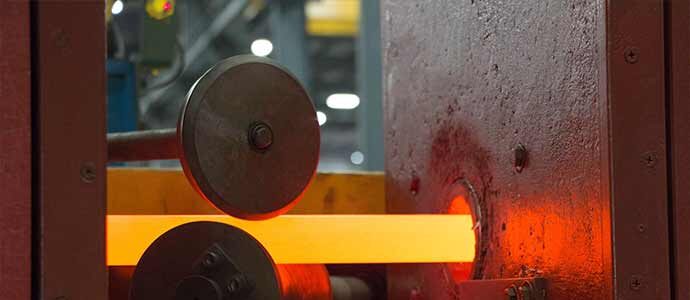
Quench and Tempering Steel Bar
Strengthen your steel products to meet design specifications with quench and tempered steel. Explore the quenching and tempering processes, how they improve iron-based alloys and the requirement specifications a quality steel supplier can deliver.
What Is Quenching and Tempering?
This process heats up the steel or other alloy in a precise way, then cools it rapidly. Similar to other heat treatments, the goal is to alter the physical and mechanical properties of the alloy. Heat treatments can be performed before, after or in between manufacturing steps to create the desired characteristics. It’s used in a range of industries for producing bearings, aircraft components, tooling and other components.
The exact level of heat and cool-down time can alter the final characteristics of your steel product. A leading heat treatment provider can identify the optimal temperature and timing of steps to ensure the highest levels of consistency and integrity.
The Quenching and Tempering Steel Bar Process
The first step in the quench and tempered steel bar process is to heat the material above a critical temperature. Known as the austenitic temperature, this point is usually at or above 1,575 degrees Fahrenheit.
Once the steel reaches this extreme temperature, it’s rapidly quenched in a liquid. The medium is usually water, although oil can be used as well. A rapid quenching is necessary to suppress the change from austenite to pearlite in the steel structure. This suppressed structure is known as martensite.
The microstructure of martensite creates a hard steel bar. The mechanical and physical properties are further altered through tempering, which is performed at lower temperatures.
The entire process requires intense heat application and ample room for cooling. It’s inefficient for many facilities to create a quenching and tempering line, so work with a heat-treated steel bar supplier to source treated alloys for your facility.
Benefits of Quench and Tempered Steel Bar
Choose to quench and temper your steel bar to provide stress relief for the steel bar. This process is popular after a harsh manufacturing process that may have created stress in the steel. Quenching and tempering is a way to restructure the steel grain and reduce the brittleness that comes from high-impact manufacturing or other processing steps.
This process also increases consistency throughout your steel bar. Instead of case hardening approaches, quenching and tempering increases strength and reduces brittleness throughout the bar or component.
Non-symmetrical part manufacturing can create brittleness and distortion. Quenching enhances durability in a symmetrical way to combat distortion in finished parts. It can smooth out any inconsistencies in the steel bar, whether naturally in the steel or introduced as part of your manufacturing process.
Requirement Specifications
There are many quench and tempered steel specifications that must be strictly met by your heat treatment provider. When you order heat-treated steel from an industry-leading supplier, you need to be sure you receive a steel bar that complies with your strict product tolerances.
At King Steel, our product line and heat treatment capabilities cover a range of requirement specifications. Explore these specifications to see if we offer you the durable, tempered steel you need in your manufacturing process:
- A434
- A193B7
- F1554GR105
- A722 Modified
- A354
- A320/L7
- A449
Contact the experts at King Steel Corp to talk about which steel products you need for your next project.